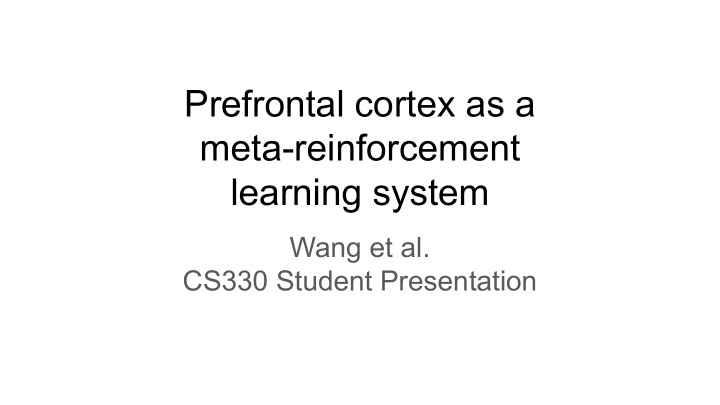



Prefrontal cortex as a meta-reinforcement learning system Wang et al. CS330 Student Presentation
Motivation ● Computational Neuro: AI <> Neurobio Feedback Loop ○ Convolutions and the eye, SNNs and Learning Rules, etc. ● Meta Learning to Inform Biological Systems ○ Canonical Model of Reward-Based Learning ■ dopamine 'stamps in' associations between situations, actions and rewards by modulating the strength of synaptic connections between neurons. ○ Recent findings have placed this standard model under strain. ■ neural activity in PFC appears to reflect a set of operations that together constitute a self-contained RL algorithm New model of Reward Based Learning - proposes a insights from Meta-RL ● that explain these recent findings ○ 6 simulations - tie experimental neuroscience data to matched Meta-RL outputs
Modeling Assumptions ● System Architecture ○ PFC (and basal ganglia, thalamic nuclei) as an RNN ○ Inputs : Perceptual data with accompanying information about actions and rewards ○ Outputs : triggers for actions, estimates of state value ● Learning ○ DA - RL system for synaptic learning (meta train) ■ Modified to provide RPE, in place of reward, as input to the network ○ PFC - RL system for activity based representations (meta-test) ● Task Environment ○ RL takes place on a series of interrelated tasks ○ Necessitating ongoing inference and behavioral adjustment
Model Performance - Two Armed Bandit task Exploration -> Exploitation 0.25, 0.75 (top) 0.6, 0.4 (bottom)
Model Performance - Two Armed Bandit task
Simulation 1 -
Simulation 1 -
Simulation 1 -
Simulation 2 ● Meta Learning on the learning rate ○ Treated as a two-armed bandit task ○ Stable periods vs volatile periods (re: pay-off probabilities) ● Different environment structures will lead to different learning rules
Simulation 3 ● Visual target appeared to the left or right of a display ● Left or right targets yielded juice rewards and sometimes the roles reversed ○ Whenever the rewards reversed, the dopamine response changed to the other target also changed which show that the hippocampus encodes abstract latent-state representations
Simulation 4 Two step task
Simulation 5
Simulation 6 - Experimental Setup: Overriding phasic dopamine signals redirects action selection during risk/reward decision making. Neuron Probabilistic risk/reward task (mice/optogen.) ● Choice: ‘safe’ arm that always offered a small reward (rS = 1) or a ‘risky’ arm that offered a large reward (rL = 4) p = 0.125 ● 5 forced pulls each of the safe and risky arms (in randomized pairs), followed by 20 free pulls.
Simulation 6 - Results Simulate optogenetic stimulation <> manipulating the value of the reward prediction error fed into the actor Same performance across a range of payoff parameters and dopamine interference
Extensions + Criticisms - Analyses in the paper mostly intuition based - “these charts match up” - Ideally should have stronger correlative evidence beyond this - Observation/end results based, not much to do with physical/inner mechanisms of PFC/DA - Results are compared to high level aggregated behaviors - Not much exploration/variation into reference architecture used
Overall Conclusions ● Simulations demonstrate comparisons between meta-RL and RL algorithms with human and animal tests ● Various roles of the brain and associated chemicals in creating model-based learning ● Leverage findings from neuroscience/psychology and existing AI algorithms to help explain learning
Recommend
More recommend